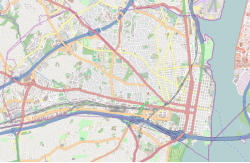Fort Ward (Virginia)
|
Fort Ward
|
|

Fort Ward's restored Northwest Bastion
|
|
| Location | 4301 W. Braddock Rd., Alexandria, Virginia |
|---|---|
| Coordinates | 38°49′50.9″N 77°6′6.6″W / 38.830806°N 77.101833°WCoordinates: 38°49′50.9″N 77°6′6.6″W / 38.830806°N 77.101833°W |
| Area | 35 acres (14 ha) |
| Built | 1861 |
| NRHP Reference # | 82004538 |
| VLR # | 100-0113 |
| Significant dates | |
| Added to NRHP | August 26, 1982 |
| Designated VLR | December 15, 1981 |
| Fort Ward | |
|---|---|
| Part of the Civil War defenses of Washington, D.C. | |
| Alexandria, Virginia | |

Gateway near the path between the museum and remnants of the fort
|
|
| Type | Earthwork fort |
| Site information | |
| Owner | City of Alexandria |
| Controlled by | Union Army |
| Open to the public |
Yes |
| Condition | Stabilized |
| Site history | |
| Built | 1861 |
| Built by | U.S. Army Corps of Engineers |
| In use | 1861–1865 |
| Materials | Earth, timber |
| Demolished | 1865 |
| Battles/wars | American Civil War |
Fort Ward is a former Union Army installation now located in the city of Alexandria in the U.S. state of Virginia. It was the fifth largest fort built to defend Washington, D.C. in the American Civil War. It is currently well-preserved with 90-95% of its earthen walls intact.
Before the outbreak of the Civil War, Alexandria County, the closest part of Virginia to Washington, D.C., was a predominantly rural area. Originally part of the District of Columbia, the land now comprising the county was retroceded to Virginia in a July 9, 1846 act of Congress that took effect in 1847. Most of the county is hilly, and at the time, most of the county's population was concentrated in the city of Alexandria, at the far southeastern corner of the county. In 1861, the rest of the county largely consisted of scattered farms, the occasional house, fields for grazing livestock, and Arlington House, owned by Mary Custis, wife of Robert E. Lee.
Following the surrender of Fort Sumter in Charleston, South Carolina, on April 14, 1861, new American president Abraham Lincoln declared that "an insurrection existed," and called for 75,000 troops to be called up to quash the rebellion. The move sparked resentment in many other southern states, which promptly moved to convene discussions of secession. The Virginia State Convention passed "an ordinance of secession" and ordered a May 23 referendum to decide whether or not the state should secede from the Union. The U.S. Army responded by creating the Department of Washington, which united all Union troops in the District of Columbia and Maryland under one command.
Brigadier General J.F.K. Mansfield, commander of the Department of Washington, argued that Northern Virginia should be occupied as soon as possible in order to prevent the possibility of the Confederate Army mounting artillery on the hills of Arlington and shelling government buildings in Washington. He also urged the erection of fortifications on the Virginia side of the Potomac River to protect the southern terminuses of the Chain Bridge, Long Bridge, and Aqueduct Bridge. His superiors approved these recommendations, but decided to wait until after Virginia voted for or against secession.
...
Wikipedia




